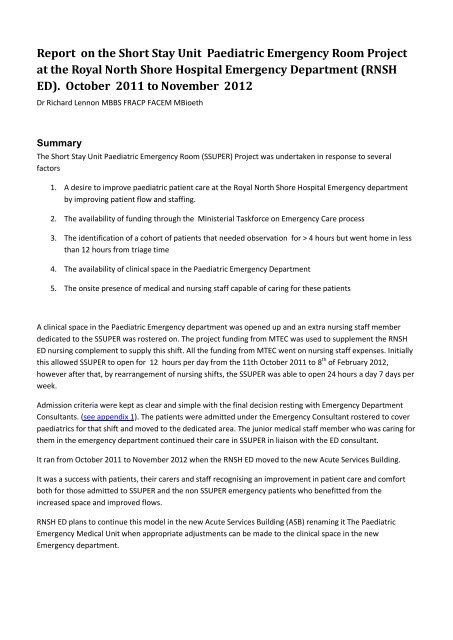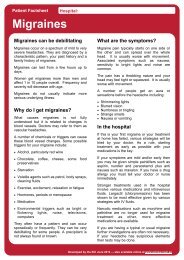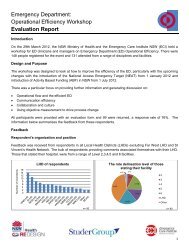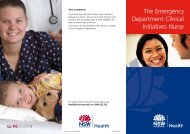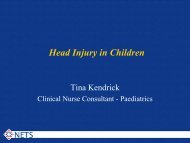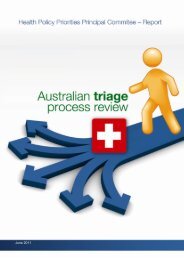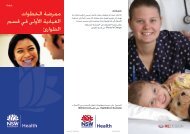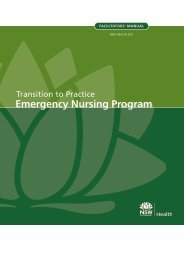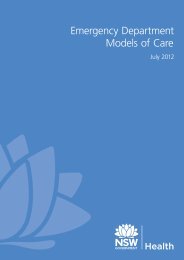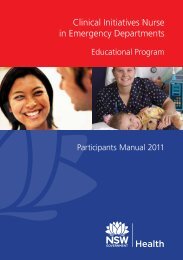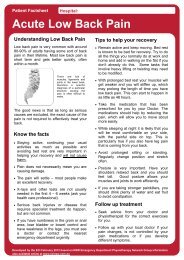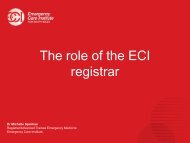Report on the Short Stay Unit Paediatric Emergency Room Project at ...
Report on the Short Stay Unit Paediatric Emergency Room Project at ...
Report on the Short Stay Unit Paediatric Emergency Room Project at ...
You also want an ePaper? Increase the reach of your titles
YUMPU automatically turns print PDFs into web optimized ePapers that Google loves.
<str<strong>on</strong>g>Report</str<strong>on</strong>g> <strong>on</strong> <strong>the</strong> <strong>Short</strong> <strong>Stay</strong> <strong>Unit</strong> <strong>Paedi<strong>at</strong>ric</strong> <strong>Emergency</strong> <strong>Room</strong> <strong>Project</strong><strong>at</strong> <strong>the</strong> Royal North Shore Hospital <strong>Emergency</strong> Department (RNSHED). October 2011 to November 2012Dr Richard Lenn<strong>on</strong> MBBS FRACP FACEM MBioethSummaryThe <strong>Short</strong> <strong>Stay</strong> <strong>Unit</strong> <strong>Paedi<strong>at</strong>ric</strong> <strong>Emergency</strong> <strong>Room</strong> (SSUPER) <strong>Project</strong> was undertaken in resp<strong>on</strong>se to severalfactors1. A desire to improve paedi<strong>at</strong>ric p<strong>at</strong>ient care <strong>at</strong> <strong>the</strong> Royal North Shore Hospital <strong>Emergency</strong> departmentby improving p<strong>at</strong>ient flow and staffing.2. The availability of funding through <strong>the</strong> Ministerial Taskforce <strong>on</strong> <strong>Emergency</strong> Care process3. The identific<strong>at</strong>i<strong>on</strong> of a cohort of p<strong>at</strong>ients th<strong>at</strong> needed observ<strong>at</strong>i<strong>on</strong> for > 4 hours but went home in lessthan 12 hours from triage time4. The availability of clinical space in <strong>the</strong> <strong>Paedi<strong>at</strong>ric</strong> <strong>Emergency</strong> Department5. The <strong>on</strong>site presence of medical and nursing staff capable of caring for <strong>the</strong>se p<strong>at</strong>ientsA clinical space in <strong>the</strong> <strong>Paedi<strong>at</strong>ric</strong> <strong>Emergency</strong> department was opened up and an extra nursing staff memberdedic<strong>at</strong>ed to <strong>the</strong> SSUPER was rostered <strong>on</strong>. The project funding from MTEC was used to supplement <strong>the</strong> RNSHED nursing complement to supply this shift. All <strong>the</strong> funding from MTEC went <strong>on</strong> nursing staff expenses. Initiallythis allowed SSUPER to open for 12 hours per day from <strong>the</strong> 11th October 2011 to 8 th of February 2012,however after th<strong>at</strong>, by rearrangement of nursing shifts, <strong>the</strong> SSUPER was able to open 24 hours a day 7 days perweek.Admissi<strong>on</strong> criteria were kept as clear and simple with <strong>the</strong> final decisi<strong>on</strong> resting with <strong>Emergency</strong> DepartmentC<strong>on</strong>sultants. (see appendix 1). The p<strong>at</strong>ients were admitted under <strong>the</strong> <strong>Emergency</strong> C<strong>on</strong>sultant rostered to coverpaedi<strong>at</strong>rics for th<strong>at</strong> shift and moved to <strong>the</strong> dedic<strong>at</strong>ed area. The junior medical staff member who was caring for<strong>the</strong>m in <strong>the</strong> emergency department c<strong>on</strong>tinued <strong>the</strong>ir care in SSUPER in liais<strong>on</strong> with <strong>the</strong> ED c<strong>on</strong>sultant.It ran from October 2011 to November 2012 when <strong>the</strong> RNSH ED moved to <strong>the</strong> new Acute Services Building.It was a success with p<strong>at</strong>ients, <strong>the</strong>ir carers and staff recognising an improvement in p<strong>at</strong>ient care and comfortboth for those admitted to SSUPER and <strong>the</strong> n<strong>on</strong> SSUPER emergency p<strong>at</strong>ients who benefitted from <strong>the</strong>increased space and improved flows.RNSH ED plans to c<strong>on</strong>tinue this model in <strong>the</strong> new Acute Services Building (ASB) renaming it The <strong>Paedi<strong>at</strong>ric</strong><strong>Emergency</strong> Medical <strong>Unit</strong> when appropri<strong>at</strong>e adjustments can be made to <strong>the</strong> clinical space in <strong>the</strong> new<strong>Emergency</strong> department.
BackgroundRNSH ED has over <strong>the</strong> last 15 years developed an excellent model for paedi<strong>at</strong>ric emergency care. Since 1997<strong>the</strong>re has been a dedic<strong>at</strong>ed area of <strong>the</strong> department for paedi<strong>at</strong>rics with doors th<strong>at</strong> are closed to <strong>the</strong> adjacentadult secti<strong>on</strong>s. This prevents utilis<strong>at</strong>i<strong>on</strong> of paedi<strong>at</strong>ric beds by adult p<strong>at</strong>ients while allowing easy access to allareas by staff. There has also been <strong>the</strong> establishment of 24 hour 7 day per week dedic<strong>at</strong>ed paedi<strong>at</strong>ric JuniorMedical Staff separ<strong>at</strong>ely rostered from <strong>the</strong> adult secti<strong>on</strong> but with flexibility to work in o<strong>the</strong>r parts of <strong>the</strong>department when <strong>the</strong>re is gre<strong>at</strong>er need and vice versa. These Junior Medical Officers (JMO) are a mixture of<strong>Paedi<strong>at</strong>ric</strong> and <strong>Emergency</strong> Medicine Trainees. There were also 1 to 2 nursing staff specifically alloc<strong>at</strong>ed to <strong>the</strong>area. During <strong>the</strong> night shift when <strong>the</strong>re are no JMOs <strong>on</strong> <strong>the</strong> Children’s Ward <strong>at</strong> RNSH <strong>the</strong> <strong>Paedi<strong>at</strong>ric</strong> ED registrarwould cover <strong>the</strong> ward necessit<strong>at</strong>ing <strong>at</strong> least <strong>on</strong>e visit every shift and usually more. Our children’s ward is alevel 4 unit and <strong>the</strong>refore does not have a High dependency unit. P<strong>at</strong>ients requiring ICU are transferred to <strong>the</strong>children’s hospitals by NETS.<strong>Paedi<strong>at</strong>ric</strong> present<strong>at</strong>i<strong>on</strong>s to RNSH ED have been steadily increasing over <strong>the</strong>se years and access block withovercrowding were becoming an issue. Nursing staff were often overwhelmed with <strong>the</strong> demands <strong>on</strong> <strong>the</strong>ir time.In 2011 a review by Mrs Clare Davies <strong>the</strong> paedi<strong>at</strong>ric CNC <strong>at</strong> RNSH and o<strong>the</strong>rs of our p<strong>at</strong>ient movementsidentified a group of p<strong>at</strong>ients th<strong>at</strong> stayed in ED for 4 to 12 hours and was discharged home. The serendipitousavailability of MTEC funding for projects to improve flow lead to <strong>the</strong> establishment of SSUPER.Types of P<strong>at</strong>ients admitted to SSUPERDiagnosesTable 1 Outlines <strong>the</strong> Diagnoses of P<strong>at</strong>ients admitted to SSUPER sorted in descending order of frequency.Asthma and Head injury were <strong>the</strong> 2 most comm<strong>on</strong> diagnoses. However <strong>the</strong>re was a wide range of paedi<strong>at</strong>ricmedical, surgical and mental health problems admitted. 171 different diagnoses are summarised in <strong>the</strong> table.Table 1 Diagnoses of those admitted to SSUPERDiagnostic Groups Number of Present<strong>at</strong>i<strong>on</strong>s Number of pres %Asthma 131 23.6%Head injury 87 15.7%O<strong>the</strong>r Medical 51 9.2%Allergic reacti<strong>on</strong> 43 7.7%Croup 31 5.6%Trauma not head injury 30 5.4%Gastroenteritis 28 5.0%Vomiting 27 4.9%Viral illness 20 3.6%Br<strong>on</strong>chiolitis 19 3.4%Abdominal pain 18 3.2%C<strong>on</strong>vulsi<strong>on</strong>/Seizure 16 2.9%Toxicology 14 2.5%O<strong>the</strong>r 18 3.2%Fever 10 1.8%Surgical 9 1.6%Mental Health 3 0.5%Grand Total 555 100.0%
AgesFigure 1 depicts <strong>the</strong> ages of p<strong>at</strong>ients admitted to SSUPER.Number of SSUPER pt in each age group180160140120100806040200Ages of SSUPER pts< 4 weeks 4 w to 1 y 1y to 2y 2y to 5y 5y to 12 y 12y to 16y >16yAge GroupNumbers of P<strong>at</strong>ients admitted to SSUPERTable 2 - Royal North Shore Hospital <strong>Emergency</strong> Department Paediactric Admissi<strong>on</strong>sby VolumeTab;e 2 shows <strong>the</strong> number of p<strong>at</strong>ients admitted to SSUPER compared to overall admissi<strong>on</strong>s and present<strong>at</strong>i<strong>on</strong>s.SSIPER admissi<strong>on</strong>s Started <strong>at</strong> about 10% of all admissi<strong>on</strong>s and <strong>the</strong>n rose to about 20% when <strong>the</strong> service wasavailable 24 hours 7 days per week.
Table 3Table 3 Shows <strong>the</strong> number of admissi<strong>on</strong>s to SSUPER th<strong>at</strong> eventually were admitted to <strong>the</strong> children’s ward.Overall <strong>the</strong>se were 16% of <strong>the</strong> total SSUPER admissi<strong>on</strong>s a little bit higher than our target of 10%. However itproved difficult to predict <strong>the</strong> course of some illnesses <strong>at</strong> admissi<strong>on</strong> expecially for Br<strong>on</strong>chiolitis see Table 4Table 4 Transfers from SSUPER to Children’s ward by diagnosesDiagnostic GroupsNumber ofPresent<strong>at</strong>i<strong>on</strong>sNumber transferredfrom SSUPER to CWTransferred%Br<strong>on</strong>chiolitis 19 10 52.6%Viral illness 20 7 35.0%Surgical 9 3 33.3%Gastroenteritis 28 8 28.6%Asthma 131 37 28.2%C<strong>on</strong>vulsi<strong>on</strong>/Seizure 16 3 18.8%O<strong>the</strong>r 18 3 16.7%O<strong>the</strong>r Medical 51 7 13.7%Vomiting 27 3 11.1%Fever 10 1 10.0%Croup 31 3 9.7%Toxicology 14 1 7.1%Abdominal pain 18 1 5.6%Head injury 87 1 1.1%Allergic reacti<strong>on</strong> 43 0 0.0%Trauma not head injury 30 0 0.0%Mental Health 3 0 0.0%
Length of <strong>Stay</strong>Table 5 shows <strong>the</strong> average length of stay of p<strong>at</strong>ients who were admitted to SSUPER both from triage time toSSUPER admissi<strong>on</strong> and from SSUPER admissi<strong>on</strong> to discharge. P<strong>at</strong>ients were averaging a little over 7 hour inhospital during <strong>the</strong> project. Table 5Comparis<strong>on</strong> with N<strong>on</strong> SSUPER timeSt<strong>at</strong>istical comparis<strong>on</strong>s with times before SSUPER was opened was limited by <strong>the</strong> introducti<strong>on</strong> of a new p<strong>at</strong>ienttracking system, Firstnet, in July 2011. C<strong>on</strong>sequently most comparis<strong>on</strong>s are between 1 st of July 2011 until <strong>the</strong>10 th of October 2011 (<strong>the</strong> Pre SSUPER period) and <strong>the</strong> SSUPER period.There was an improvement in <strong>the</strong> flow of p<strong>at</strong>ients in general because of <strong>the</strong> extra space and Nursing Staffopened up. This is dem<strong>on</strong>str<strong>at</strong>ed by <strong>the</strong> fact th<strong>at</strong> <strong>the</strong> time to be first seen by a doctor after triage improvedfrom an average of 40 minutes in <strong>the</strong> pre SSUPER time to 33 minutes in <strong>the</strong> SSUPER period.N<strong>at</strong>i<strong>on</strong>al <strong>Emergency</strong> Access Target (NEAT, in this report this means discharge from ED in < 4hours from time oftriage) performance also improved going from an average of 67% in <strong>the</strong> Pre SSUPER period to 72.6% in <strong>the</strong>SSUPER period. In <strong>the</strong> Pre SSUPER period NEAT performance for all p<strong>at</strong>ients admitted was 27%. Throughout<strong>the</strong> SSUPER period <strong>the</strong> NEAT performance of all p<strong>at</strong>ients admitted to SSUPER and <strong>the</strong> children’s ward was 33%.During <strong>the</strong> SSUPER period those admitted to SSUPER had a better NEAT performance than those admitted to<strong>the</strong> ward (56% vs 28%). However both are well below <strong>the</strong> target for th<strong>at</strong> year of 70% an issue which isdiscussed in <strong>the</strong> Challenges secti<strong>on</strong> of this report. Admissi<strong>on</strong> r<strong>at</strong>es rose during <strong>the</strong> SSUPER period as comparedwith <strong>the</strong> Pre SSUPER period (19.8% vs 16.4%) some of this increase would be due to SSUPER p<strong>at</strong>ients th<strong>at</strong> in <strong>the</strong>pre SSUPER period would have languished unadmitted in <strong>the</strong> department.
P<strong>at</strong>ient FeedbackAnecdotally parent’s opini<strong>on</strong>s of SSUPER were good to excellent. A small sample of p<strong>at</strong>ients was surveyed <strong>on</strong><strong>the</strong>ir level of s<strong>at</strong>isfacti<strong>on</strong> (see <strong>the</strong> survey form in appendix 2). 69% r<strong>at</strong>ed <strong>the</strong>ir experience of overall care <strong>at</strong>RNSH as excellent with <strong>the</strong> remaining 31% r<strong>at</strong>ing it as good or very good. The r<strong>at</strong>ing of <strong>the</strong>ir experience inSSUPER itself was 75% excellent with <strong>the</strong> rest being good or very good. When asked if <strong>the</strong>y would preferadmissi<strong>on</strong> to SSUPER as opposed to an overnight stay <strong>on</strong> <strong>the</strong> ward 75% agreed or str<strong>on</strong>gly agreed, 19% wereuncertain and 6% str<strong>on</strong>gly disagreed. The least s<strong>at</strong>isfied p<strong>at</strong>ients were those who ended up being transferredfrom SSUPER to Children’s ward. This is discussed fur<strong>the</strong>r in <strong>the</strong> Challenges secti<strong>on</strong> of this reportStaff feedbackThe ED staffs’ opini<strong>on</strong>s of SSUPER were almost universally positive. Most saw it oper<strong>at</strong>ing in a very similar wayto <strong>the</strong> Adult EDs <strong>Emergency</strong> Medicine <strong>Unit</strong> (EMU) and thus were very comfortable with moving p<strong>at</strong>ientsthrough in this way. The proximity of <strong>the</strong> SSUPER to <strong>the</strong> <strong>Paedi<strong>at</strong>ric</strong> ED meant th<strong>at</strong> it was not a problem forJunior Medical staff to c<strong>on</strong>tinue care of <strong>the</strong>ir ED p<strong>at</strong>ients in SSUPER and th<strong>at</strong> <strong>the</strong> nurse covering SSUPER couldassist in <strong>Paedi<strong>at</strong>ric</strong> ED and vice versa. Since moving to our new ED in <strong>the</strong> RNSH ASB 3 weeks ago <strong>the</strong> SSUPERproject has been wound up and staff have commented th<strong>at</strong> <strong>the</strong>y miss it. This is fur<strong>the</strong>r evidence of its utilityChallenges/future plansInfectious p<strong>at</strong>ientsThe lack of an isol<strong>at</strong>i<strong>on</strong> bed excluded many p<strong>at</strong>ients th<strong>at</strong> would have been o<strong>the</strong>rwise suitable for SSUPER. Forexample; <strong>the</strong>re were 656 p<strong>at</strong>ients with some form of gastroenteritis who were discharged with a mean lengthof stay of 190 minutes and 173 of <strong>the</strong>m stayed more than 4 hours. Ano<strong>the</strong>r 115 were admitted to <strong>the</strong> children’sward; some of those may have been suitable for rehydr<strong>at</strong>i<strong>on</strong> in SSUPER and discharge. This would have lead toan approxim<strong>at</strong>e 30% increase in SSUPER admissi<strong>on</strong>s. Despite <strong>the</strong> ban <strong>on</strong> infectious p<strong>at</strong>ients 5% of thoseadmitted to SSUPER had a diagnosis of Gastroenteritis. In most of <strong>the</strong>se cases <strong>the</strong> diagnosis was not apparentuntil after admissi<strong>on</strong> to SSUPER. There were no reported cases of cross infecti<strong>on</strong>.P<strong>at</strong>ients needing transfer to Children’s ward16% of p<strong>at</strong>ients needed transfer to children’s ward and transfer of care from <strong>the</strong> ED specialist to <strong>the</strong>paedi<strong>at</strong>rician. This was <strong>the</strong> most frequent cause of parent diss<strong>at</strong>isfacti<strong>on</strong>. Attempt to reduce this fracti<strong>on</strong> bymore careful selecti<strong>on</strong> early in <strong>the</strong> SSUPER period lead to underutilis<strong>at</strong>i<strong>on</strong> and l<strong>at</strong>er admissi<strong>on</strong> to SSUPER. Itseems th<strong>at</strong> progress of sick children is difficult to predict especially in <strong>the</strong> very young. In <strong>the</strong> end a policy ofadmitting to SSUPER and early c<strong>on</strong>sult<strong>at</strong>i<strong>on</strong> with paedi<strong>at</strong>ricians if <strong>the</strong>re was a c<strong>on</strong>cern th<strong>at</strong> <strong>the</strong> SSUPER p<strong>at</strong>ientswere not going to get home was <strong>the</strong> best policy. In future in our <strong>Paedi<strong>at</strong>ric</strong> EMU we plan to set <strong>the</strong> target fordischarge home <strong>at</strong> 80%. This will allow staff to feel more comfortable about admitting p<strong>at</strong>ients to SSUPERearlier in <strong>the</strong>ir stay in ED thus improving <strong>the</strong> flow of p<strong>at</strong>ients through <strong>the</strong> department and our NEATperformance.Improving average length of stay and Ne<strong>at</strong> performance for those admitted toSSUPERAs noted above 56% NEAT performance for those admitted to SSUPER is well below target. Associ<strong>at</strong>ed withthis was <strong>the</strong> fact th<strong>at</strong> <strong>the</strong> average length of stay for all p<strong>at</strong>ients in <strong>the</strong> SSUPER period was 202 minutes, in <strong>the</strong>pre SSUPER period it was 211 minutes an improvement of 5%. This was less than hoped for and <strong>on</strong>e of <strong>the</strong>reas<strong>on</strong>s was outlined above. Ano<strong>the</strong>r reas<strong>on</strong> is th<strong>at</strong> because <strong>the</strong> SSUPER admissi<strong>on</strong> criteria menti<strong>on</strong>ed 4 hoursth<strong>at</strong> staff often waited until 4 hours was up before making <strong>the</strong> decisi<strong>on</strong>. A third reas<strong>on</strong> was <strong>the</strong> lack of
awareness of NEAT performance criteria am<strong>on</strong>g staff. Changing <strong>the</strong> trigger time to 3 hours and educ<strong>at</strong>ing staff<strong>on</strong> NEAT criteria will improve this in future.Size of SSUPERAt most times 2 beds were adequ<strong>at</strong>e however <strong>at</strong> our busiest times especially during winter sports seas<strong>on</strong> <strong>on</strong>S<strong>at</strong>urdays SSUPER was full and appropri<strong>at</strong>e p<strong>at</strong>ients could not get in. It is difficult to overcome this problem in afixed bed ward.The requirements for a short stay unitIn <strong>the</strong> n<strong>at</strong>i<strong>on</strong>al agreement <strong>on</strong> NEAT short stay units are defined as being a“<strong>Short</strong> <strong>Stay</strong> <strong>Unit</strong>s or <strong>the</strong>ir equivalent must have <strong>the</strong> following characteristics i :• design<strong>at</strong>ed and designed for <strong>the</strong> short term tre<strong>at</strong>ment, observ<strong>at</strong>i<strong>on</strong>, assessment and reassessment ofp<strong>at</strong>ients initially triaged and assessed in <strong>the</strong> emergency department;• have specific admissi<strong>on</strong> and discharge criteria and policies;• designed for short term stays no l<strong>on</strong>ger than 24 hours;• physically separ<strong>at</strong>ed from <strong>the</strong> emergency department acute assessment area;• have a st<strong>at</strong>ic number of beds with oxygen, sucti<strong>on</strong> and p<strong>at</strong>ient abluti<strong>on</strong> facilities; and• not a temporary emergency department overflow area nor used to keep p<strong>at</strong>ients solely awaiting aninp<strong>at</strong>ient bed nor awaiting tre<strong>at</strong>ment in <strong>the</strong> emergency department.”SSUPER s<strong>at</strong>isfied all <strong>the</strong>se requirements except perhaps th<strong>at</strong> it was not physically separ<strong>at</strong>e from <strong>the</strong> emergencydepartment. It was 2 previously unused bed spaces in a corner of <strong>the</strong> paedi<strong>at</strong>ric ED; <strong>the</strong>re was no physical wallbetween it and <strong>the</strong> <strong>Paedi<strong>at</strong>ric</strong> ED. If <strong>the</strong> meaning of “physical separ<strong>at</strong>e” was th<strong>at</strong> <strong>the</strong>y were not virtual bedswhere a p<strong>at</strong>ient was admitted to SSUPER and <strong>the</strong>ir ED bed became a SSUPER bed <strong>the</strong>n this model s<strong>at</strong>isfied th<strong>at</strong>criteria. The same 2 bed spaces were always <strong>the</strong> SSUPER beds and p<strong>at</strong>ients were physically moved to thosespaces. However if <strong>the</strong> meaning requires a wall or partiti<strong>on</strong> between <strong>the</strong> ED and SSUPER it does not s<strong>at</strong>isfy th<strong>at</strong>criteria. Is a wall necessary? I have already outlined <strong>the</strong> advantages of <strong>the</strong> proximity for staff. The advantagesfor p<strong>at</strong>ients included <strong>the</strong> fact th<strong>at</strong> <strong>the</strong>y could use <strong>the</strong> play equipment in <strong>the</strong> paedi<strong>at</strong>ric ED secti<strong>on</strong> and <strong>the</strong>ycould easily get <strong>the</strong> <strong>at</strong>tenti<strong>on</strong> of <strong>the</strong>ir tre<strong>at</strong>ing doctors if needed. One disadvantage is th<strong>at</strong> <strong>the</strong>re could be noisol<strong>at</strong>i<strong>on</strong> in SSUPER ano<strong>the</strong>r is <strong>the</strong> loss of differenti<strong>at</strong>i<strong>on</strong> between SSUPER p<strong>at</strong>ients and ED p<strong>at</strong>ients th<strong>at</strong>sometimes occurred in <strong>the</strong> minds of <strong>the</strong> staff. Our proposed soluti<strong>on</strong> is a PEMU with <strong>at</strong> least <strong>on</strong>e isol<strong>at</strong>i<strong>on</strong> roomand <strong>on</strong>e o<strong>the</strong>r bed partiti<strong>on</strong>ed off from <strong>the</strong> main area.P<strong>at</strong>ient SafetyThere were no major adverse events reported during <strong>the</strong> SSUPER period. The <strong>on</strong>ly complaint from <strong>the</strong>paedi<strong>at</strong>ricians was th<strong>at</strong> p<strong>at</strong>ients th<strong>at</strong> were eventually admitted to <strong>the</strong> Children’s war d were observed for tool<strong>on</strong>g in SSUPER. This was an inc<strong>on</strong>venience and disappointment for <strong>the</strong> parents and p<strong>at</strong>ient but did notsignificantly change <strong>the</strong>ir management. The problem disappeared with advice to medical staff to c<strong>on</strong>sult early if<strong>the</strong> p<strong>at</strong>ient was not improving.SSUPER vs <strong>Short</strong> <strong>Stay</strong> <strong>Unit</strong> in <strong>Paedi<strong>at</strong>ric</strong> ward.In previous winters <strong>the</strong>re has been a temporary SSU set up <strong>on</strong> our children’s ward. Although <strong>the</strong>re is someoverlap <strong>the</strong> 2 models are more complementary than competitive because <strong>the</strong> SSU <strong>on</strong> children’s ward hadl<strong>on</strong>ger staying, more complic<strong>at</strong>ed p<strong>at</strong>ients and more paedi<strong>at</strong>ric medical p<strong>at</strong>ients than SSUPER (see <strong>the</strong> list ofdiagnoses in SSUPER). Also our SSU model was 12 hours per day and also took booked admissi<strong>on</strong>s. One gre<strong>at</strong>advantage of SSUPER was th<strong>at</strong> <strong>the</strong> p<strong>at</strong>ient was admitted under an ED staff specialist who was in <strong>the</strong>
department 16 hours per day. This meant <strong>the</strong> decisi<strong>on</strong> to admit was rapid and th<strong>at</strong> review by a senior specialistcould be frequent. The 2 models never oper<strong>at</strong>ed toge<strong>the</strong>r during <strong>the</strong> SSUPER period but in future we hope <strong>the</strong>ywill with fur<strong>the</strong>r benefits for p<strong>at</strong>ient c<strong>on</strong>venience and flow. The main reas<strong>on</strong> for changing <strong>the</strong> name fromSSUPER to <strong>Paedi<strong>at</strong>ric</strong> EMU in future is to bring out this complementarity.Did SSUPER reduce admissi<strong>on</strong>s to <strong>the</strong> Children’s ward?This is difficult to say for certain although <strong>the</strong> increase in admissi<strong>on</strong>s outlined above would suggest th<strong>at</strong> <strong>the</strong>answer is no. This c<strong>on</strong>firms <strong>the</strong> finding th<strong>at</strong> SSUPER p<strong>at</strong>ients were different to Children’s ward p<strong>at</strong>ients with avery short average length of stay in SSUPER of 4 hours as opposed to 12 to 24 hours or more in <strong>the</strong> ward.Applicability of SSUPER model to o<strong>the</strong>r <strong>Emergency</strong> DepartmentsAs menti<strong>on</strong> in <strong>the</strong> Background secti<strong>on</strong> of this report RNSH ED already had very good separ<strong>at</strong>e paedi<strong>at</strong>ricfacilities. On top of th<strong>at</strong> it has ED c<strong>on</strong>sultant presence 16 hours a day 7 days a week and paedi<strong>at</strong>ric registrarpresence 24/7. Many hospitals may not have <strong>the</strong>se advantages and so <strong>the</strong>ir model of a SSUPER or paedi<strong>at</strong>ricEMU may have to differ from ours. However <strong>the</strong> principles are <strong>the</strong> same; an area securely separ<strong>at</strong>ed fromadults with c<strong>on</strong>venient paedi<strong>at</strong>ric facilities but close enough to allow ED staff to easily review p<strong>at</strong>ients withadmissi<strong>on</strong> under ED c<strong>on</strong>sultants and early discussi<strong>on</strong> of possible l<strong>on</strong>g stayers with paedi<strong>at</strong>ricians.C<strong>on</strong>clusi<strong>on</strong>An often crowded <strong>Paedi<strong>at</strong>ric</strong> ED secti<strong>on</strong> with often overworked nurses was changed by <strong>the</strong> advent of SSUPERinto a less crowded calmer and happier envir<strong>on</strong>ment with Nurses who were still busy but had time to do <strong>the</strong>careful checking and important paedi<strong>at</strong>ric tasks. They could also support <strong>the</strong> doctors more expediently withprocedures (e.g. by administering Nitrous Oxide and o<strong>the</strong>r analgesics). P<strong>at</strong>ients had to spend less time in chairsand in waiting rooms because more beds were available due to better p<strong>at</strong>ient flow. SSUPER made <strong>the</strong>se andmany o<strong>the</strong>r things better for p<strong>at</strong>ients and staff and we plan to c<strong>on</strong>tinue as outlines above.ThanksBecause all <strong>the</strong> funding from MTEC went towards <strong>the</strong> Nursing Staff many people have found time andresources from <strong>the</strong>ir already busy lives to make SSUPER happen. Mr Brian McKee-H<strong>at</strong>a, Nurse Manager RNSHED, approached <strong>the</strong> project with passi<strong>on</strong> and especially did a lot of work to get SSUPER open 24 hours a day.Without his efforts it would not have succeeded. Mr Marko Hallikainen RN gave many hours of his IT genius toextract <strong>the</strong> figures from Firstnet and to work with IMT to cre<strong>at</strong>e <strong>the</strong> SSUPER ward in <strong>the</strong> hospital d<strong>at</strong>abases.Our director Dr Robert Day and our deputy director Dr Elizabeth Swinburn gave a lot of time and effort andgood advice. Having said th<strong>at</strong>, all <strong>the</strong> staff of <strong>the</strong> RNSH ED and <strong>the</strong> <strong>Paedi<strong>at</strong>ric</strong> department and those involved inadministr<strong>at</strong>i<strong>on</strong> of MTEC are to be thanked.
Appendix 1Admissi<strong>on</strong> criteria for SSUPER:Inclusi<strong>on</strong> criteriaAny paedi<strong>at</strong>ric p<strong>at</strong>ient in <strong>the</strong> ED who;1. Has a probable diagnosis2. Is likely to need to be in <strong>the</strong> department for more than 4 hours3. Has a clinical management plan th<strong>at</strong> will likely lead to discharged home within 12 hrs of admissi<strong>on</strong> toSSUPERExclusi<strong>on</strong> criteriaa. P<strong>at</strong>ients known to be infectiousb. P<strong>at</strong>ients with diarrhoeac. P<strong>at</strong>ients need a significant amount of expertise of o<strong>the</strong>r specialties apart from <strong>Emergency</strong>Medicine (eg Orthopaedics etc)O<strong>the</strong>r C<strong>on</strong>sider<strong>at</strong>i<strong>on</strong>s1. Where a child is a known p<strong>at</strong>ient of a paedi<strong>at</strong>rician especially if under <strong>the</strong>ir care for a chr<strong>on</strong>ic and/orcomplex c<strong>on</strong>diti<strong>on</strong> relevant to this present<strong>at</strong>i<strong>on</strong> discussi<strong>on</strong> with th<strong>at</strong> paedi<strong>at</strong>rician may be required toestablish whe<strong>the</strong>r <strong>the</strong> child should admitted to SSUPER or <strong>the</strong> Children’s ward2. The aim is for a maximum 12 hr stay however if a child’s 12 hrs will be completed in <strong>the</strong> early hours of<strong>the</strong> morning it is acceptable to extend <strong>the</strong>ir stay until a more reas<strong>on</strong>able hour.
Appendix 2S<strong>at</strong>isfacti<strong>on</strong> surveyi i http://www.yourhealth.gov.au/internet/yourhealth/publishing.nsf/C<strong>on</strong>tent/Expert-Panel-<str<strong>on</strong>g>Report</str<strong>on</strong>g>~Secti<strong>on</strong>-3


